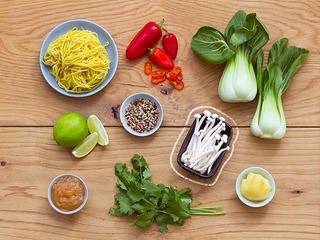Editor’s note: Our Splash Health, Wellness and Wearables event is coming up on March 23 in San Francisco. We’ll have Mario Schlosser (Founder & CEO of Oscar Health), Brian Singerman (Partner, Founders Fund), Steve Jurvetson (Draper Fisher Jurvetson), J. Craig Venter (Human Longevity), Lynne Chou (Partner, Kleiner Perkins), Michael Dixon (Sequoia Capital), Patrick Chung (Xfund), Check out the full lineup and register for tickets before they jump! If you’re a healthcare startup and you’re interested in being part of our competition, learn more and register here.
Also, vote for your favorite healthcare startup before February 16! Vote here!
—————


It’s more similar to the latter, however. While Munchery delivers prepared meals (that only require heating), Blue Apron and HelloFresh deliver a box of ingredients—you, the customer, must prepare the meals.
And just like HelloFresh, Blue Apron requires you to sign up for a weekly plan:
The Two-Person Plan, which includes three recipes (i.e. meals) and serves two people, costs $59.94 per week ($9.99 per meal).
The Family Plan, which includes two or four recipes and serves four people, costs $69.92 per week ($8.74 per meal) or $139.84 per week ($8.74).
Blue Apron, from its homepage to its packaging materials, makes a big deal about the fact that it uses “farm-fresh, seasonal produce,” hormone-free meat, and other sustainably sourced ingredients.
As it is, both of Blue Apron’s primary plans are comparable in price to HelloFresh meal plans. Like HelloFresh, Blue Apron doesn’t offer a different price and plan for vegetarians. You can order the Two-Person Plan as a vegetarian, but you’ll pay the same price.
In addition to the meals, Blue Apron also offers a wine pairing service. For $60 per month ($10 per bottle) plus $5.99 in shipping, the company delivers six bottles once per month, including a mixed selection of red and white wines. Notably, the bottles are 500 ml (2/3 of a standard-size 750ml bottle), which Blue Apron markets as “the perfect amount of wine for two to share over a meal.” (I guess my partner and I must be lushes—we have no problem polishing off the standard size bottle in a night.)
Finally, in a unique effort to increase the company’s offerings, Blue Apron also has a marketplace selling kitchen items to customers, who are presumably aspiring chefs. The marketplace includes prep tools (including a chef & petty knife set for $139.99), wine glasses and chillers, cookbooks (one for each season at $29.99 per book), and more. You can also purchase gift cards or, of course, the blue apron from Blue Apron’s logo.
Blue Apron, as with its many competitors in the foodtech and delivery space, is still a private company and doesn’t disclose much in the way of financials or membership figures.
That said, we know the company has raised approximately $194 million in venture capital from Bessemer Venture Partners, First Round Capital, Stripes Group, and others. The bulk of its funding came in the form of a $135 million Series D led by Fidelity Management and Research Company in June 2015.
The company has been reported to be one of a couple dozen that could go public in 2017, most recently by CB Insights. But Bloomberg reported last month that the impending IPO has been put on hold—made evident by a delay in selecting bankers—so that Blue Apron can first improve its financials. Today the company brings in a reported $800 million in annual revenue, though it’s likely the IPO is being put off due to slim profits.



















